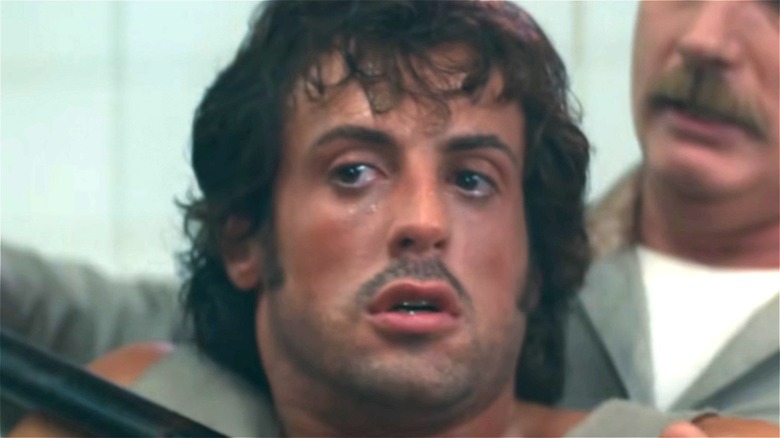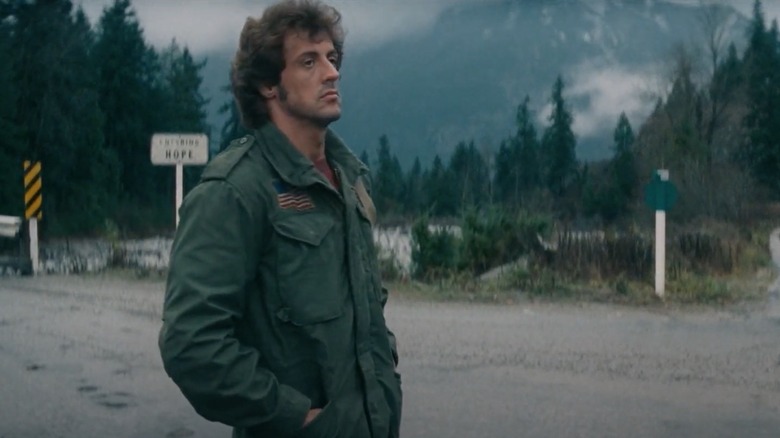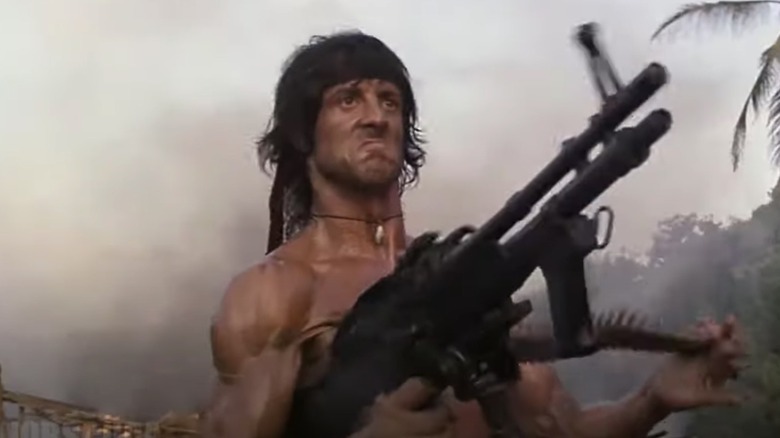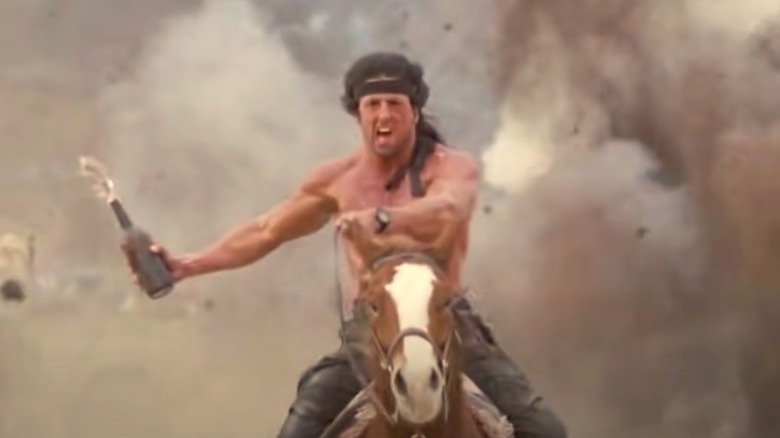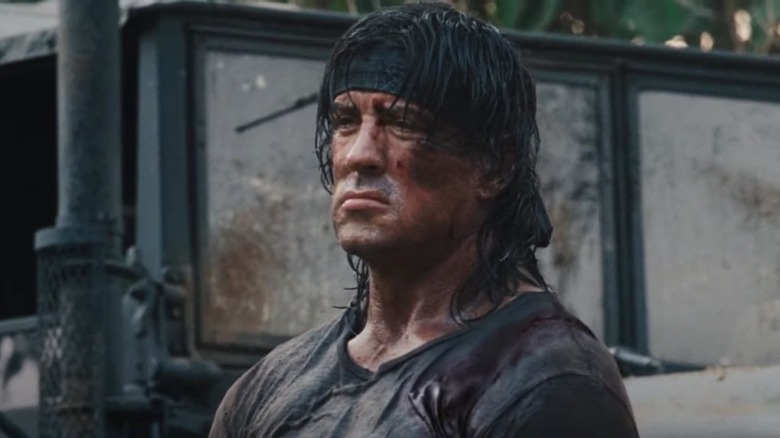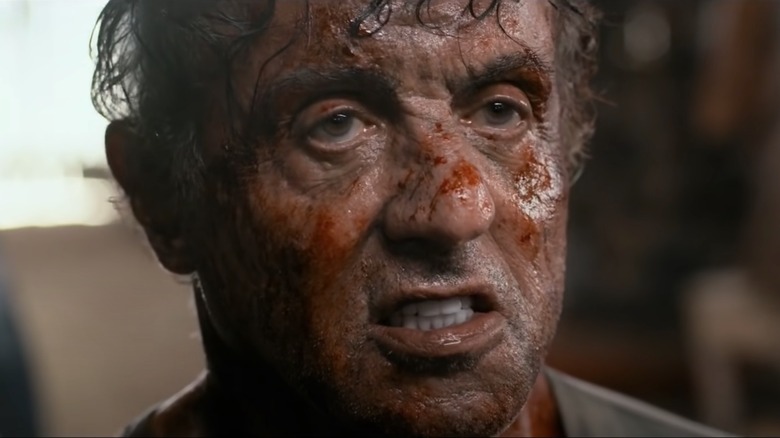The Correct Order In Which To Watch The Rambo Movies
Of all the major action franchise to emerge from the 1980s, the one fronting Sylvester Stallone's tortured, and incredibly lethal Vietnam veteran John Rambo was arguably the least likely. And yet, even as the first film in the franchise — 1982's surprisingly soulful, character-driven actioner "First Blood" — hardly begged for a sequel, follow-ups didn't take long to appear. By the end of the decade, producers had released not one, but two more deliriously over-the-top "Rambo" movies. The minds behind the "Rambo" franchise didn't stop there either, releasing two more action-packed epics that surprisingly made their debuts decades after the third film hit theaters.
You're reading that right, action fans: as of this writing there are actually five films in the "Rambo" franchise. While there's no guarantee a new chapter, prequel, or reboot will never get made, if you're dying to experience John Rambo's entire big screen story to date in the correct order, this is the way to do it.
First Blood is a compelling opening chapter in the Rambo saga
The "Rambo" franchise has never been one most moviegoers might refer to as "insightful," or even "innovative." To that point, the minds behind the "Rambo" franchise didn't try to get tricky with the character's narrative arc by sneaking a prequel or a spin-off into the middle of the pack — meaning the five movies in the franchise can, and should, be watched in the order in which they were released.
As for the opening chapter in the bloody John Rambo saga, it had quite a lot to say about the treatment of Vietnam vets upon their return home. That it addresses that topic in the context of a Hollywood-styled action bonanza might put some people off. But at its core, "First Blood" is a war-at-home film in two distinct halves, succinctly fronting its message before letting all hell break loose.
Indeed, the opening of "First Blood" is basically a harrowing, character-driven drama which finds Stallone's former Green Beret John Rambo making his way to the town of Hope, Washington to reconnect with an old war buddy. There, he finds himself promptly tormented and tortured by a local sheriff (Brian Dennehy) and his sadistic officers. Triggered by the vicious mistreatment, the second half of "First Blood" finds Rambo fighting his way free of the deputies, whereupon he leads them into the woods, and uses guerrilla war tactics to take his revenge in a brutal campaign as thrilling as it is thoughtful and tragic.
Rambo: First Blood Part II is a sequel that gives new meaning to the term 'over-the-top'
The jury was out as to whether Rambo would survive "First Blood," particularly since he dies in the book that inspired the film. He did make it through, though,eventually surrendering to his old C.O. Colonel Trautman (Richard Crenna) and Federal authorities.
When we catch up with Rambo in 1985's "Rambo: First Blood Part II," the lethal vet is doing time in a labor camp, and the war in Vietnam is long over. It's there that Trautman seeks him out, offering the imprisoned vet reinstatement to the U.S. Army before tasking him with a dangerous mission — return to Vietnam and track down a prisoner of war camp holding a group of U.S. soldiers.
Rambo is also given explicit orders not to try and rescue those prisoners himself, and if you know anything about John Rambo, you know the odds of his following that order ... are slim, to say the least. Sure enough, Rambo goes the one-man-army route in liberating his imprisoned comrades, doing so in such over-the-top fashion that any of the messaging regarding P.O.W.s in Vietnam — of which there were still thousands when the film was released — is lost in the overt bombast.
To be clear, the second "Rambo" flick is pretty much the poster child for Hollywood excess of the 1980s, which is reflected in its less-than-fresh Rotten Tomatoes score. But said excess is, of course, reason enough to check it out, if that's your bag.
Rambo III was a low point for the franchise
If "Rambo: First Blood Part II" was a shamefully over-the-top affair, then "Rambo III" is very much a "hold my beer" sort of sequel that spun so dramatically sideways in every way, it plays more as comedy-of-excess than pulse-pounding action spectacular. Still, as is the case with every "Rambo" film to date, part three still tackled a timely political topic, this time addressing U.S. involvement in the conflict between Russia and Afghanistan.
Politics are very much an afterthought for "Rambo III," though, which opens a few years after Rambo's explosive return to Vietnam, and then finds the army-of-one trying to live the peaceful life in a Thai monastery. He's also funding a construction project on monastery grounds by fighting bare-knuckle bouts in nearby Bangkok. Needing some muscle, Trautman eventually reaches out Rambo, and tries to enlist him in a CIA-sponsored mission to help arm an Afghani tribe against the invading Soviet Army.
Rambo declines. But once he learns that the mission did not go according to plan, and Trautman is being held prisoner by Soviet forces, the super soldier takes his lethal talents to the Afghani desert to free his old ally. From there, "Rambo" goes the way of its predecessor with the all-but un-killable soldier laying waste to Soviet forces with mind-boggling efficiency before he and Trautman ride off into the sunset in pseudo cowboy style.
Rambo is pretty much gore-porn for the action set
Given the tepid critical response to "Rambo III" (per Rotten Tomatoes), it seemed the franchise would likely end as a trilogy. Frankly, it probably should have. But 20 years after John Rambo shot fire through his torso, and decimated a Soviet military outpost on horseback, Stallone shocked the whole of cinema by not only reprising one of his more iconic roles, but also writing and directing the ultra-violent, critically-reviled (via Rotten Tomatoes) "Rambo."
This 2008 film finds an appropriately aged John still calling Thailand home. Having left the monastery behind, he now makes his living as a snake-catcher and riverboat captain. Rambo is called back into action after a group of missionaries he ferries into Burma on a humanitarian mission are captured by local authorities, and a mercenary team is dispatched to save them. As with every "Rambo" narrative, things soon deteriorate into a hyper-violent showdown between Rambo and a literal army of enemies.
But even by franchise standards, "Rambo" is unfathomably violent, with Stallone and his special effects team delighting in the sight of exploding heads, severed limbs, and disembowelments enough to make the "Saw" franchise blush. And if "Rambo" has anything real to say about the state of Burma at the time of the film's release, it's completely lost amid the outlandish (if stylishly rendered) arterial spray.
Rambo: Last Blood is a brutal and somber swan song
If Stallone fans were surprised when the aging star returned for "Rambo" after a 20-year break, they were likely floored when the 73-year-old actor again suited up over a decade later with 2019's "Rambo: Last Blood." Seems "Rambo" fans were surprisingly moved by his final stand too, honoring "Last Blood" with an 81% Fresh Rotten Tomatoes rating. Critics, however, did not feel the franchise saved the best for last, ranking "Last Blood" the worst of the "Rambo" movies.
The final flick finds the titular hero calling his deceased father's Arizona ranch home, and running the outfit with his old friend Maria (Adrianna Barraza) and her granddaughter Gabriela (Yvette Monreal). But when Gabriela is kidnapped, brutalized, and eventually murdered by drug cartel baddies on a trip to Mexico, Rambo turns his blood-lusting eyes to bringing the cartel down on his own.
Yes, "Last Blood" is an atypical "drug cartels are bad" kind of movie. And yes, Rambo takes his revenge in vintage Rambo fashion. While it lacks grace, and originality, "Last Blood" is still a suitable enough final chapter in the "Rambo" saga which, amid the often groan-worthy barbarism, aims to deliver a wildly unconventional hero's journey about a broken soul searching for peace, justice, and hope in an ocean of blood and misery. Whether or not it achieves that goal is up to the viewer.
